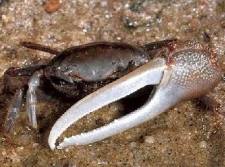Wildlife - Species

Fiddler Crab (Uca pugnax)
Description
Fiddler crabs are easily recognized by their square body and marked difference in size between the right and left claws of males. As the male grows to maturity, the relative weight of its large claw, or cheliped, changes from 2% to 65% of its total body weight. Mud fiddlers, Uca pugnax, have an H-shaped depression in the middle of the carapace and their eyestalks are long and thin. They are brown in color, with the front of the shell and eyestalks ranging from blue to turquoise. The large claw of the male is usually yellowish orange to yellowish white, and its walking legs are dark and banded. Besides mud fiddlers, two other species of fiddler crabs are common along the southeastern Atlantic coast: Uca pugilator, the sand fiddler; and Uca minax, the red-jointed fiddler. The three are easily differentiated on the basis of anatomical features and preferred habitat: sand fiddlers inhabit sandy habitats, they are typically a pinkish-purple color, and the inside of the male's large claw lacks a row of small bumps; mud fiddlers are a brownish-yellowish color, they prefer muddy areas, and the inside of the male's large claw has a row of small granules; red-jointed fiddlers are larger than the other two species, and the joints of the male's large claw are red.
Preferred Habitat and Biology
Fiddler crabs are one of the most conspicuous inhabitants of the intertidal zone, and they often can be seen foraging in large groups along creek banks when the tide is out. They thrive in marsh habitats where the substrate is stable enough to allow for the construction of burrows, which can be up to 60 cm (23 in) deep. Mud fiddlers range from Massachusetts to Florida and are common along the South Carolina coast.
Male fiddler crabs wave their oversized claw up and down to attract the attention of females for mating and to intimidate potential male competitors. They also stomp their walking legs and make noises with them in an effort to attract mates. Such displays reach a peak during spring tides, and mating occurs thereafter inside the male's burrow. The female remains inside the burrow during the 2-week incubation period and then comes out to release her eggs, which are swept out to sea by neap tides. After hatching, larvae go through several developmental stages (five zoeae and a megalopal) over the two-week period that they are adrift in the ocean. They are then transported back inside estuaries on the subsequent spring tide. Larvae are predatory and feed on zooplankton in the water column. They remain pelagic for some time after reaching the megalopal stage, gradually adopting a benthic existence. Adult fiddler crabs feed on organic material extracted from mud, which is rolled into small balls after the food is removed and deposited back onto the substrate. Pellets formed during burrow excavation are much larger than feeding pellets. Mud fiddlers are adept at regulating their metabolism over a wide range of temperatures, which may explain their widespread abundance.Species Significance
This species has no directly quantifiable commercial value but constitutes an important food source for estuarine animals such as clapper rails, other marsh birds, blue crabs and many other species. As are other estuarine-dependent animals, fiddler crabs are under continuously increasing threat of habitat loss due to land use practices that alter or destroy suitable habitat.
References
Ruppert, E. and R. Fox. 1988. Seashore animals of the southeast. University of South Carolina Press, Columbia, SC.
Williams, A. B. 1984. Shrimps, lobsters and crabs of the Atlantic coast of the eastern United States, Maine to Florida. Smithsonian Institution Press, Washington, DC.
